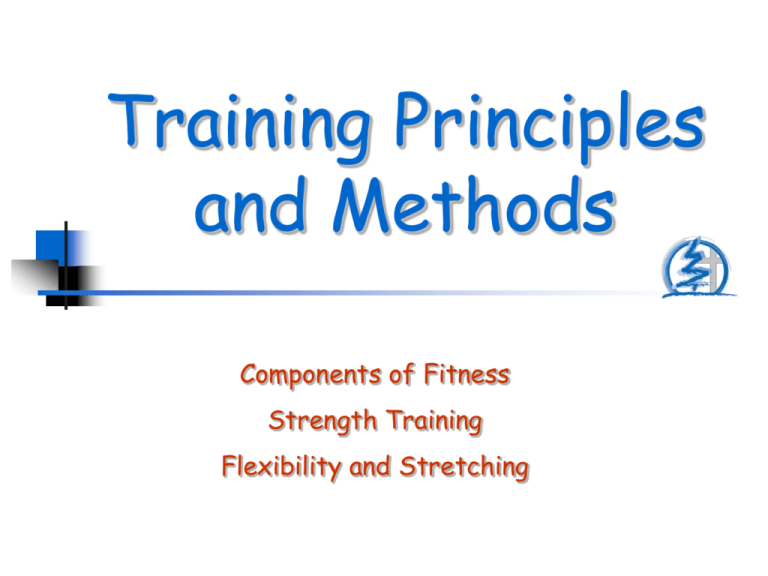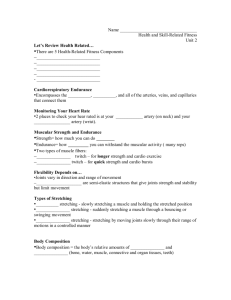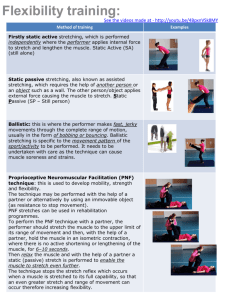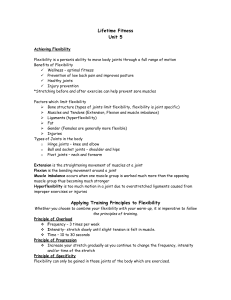Physical Fitness Defined
advertisement

Training Principles and Methods Components of Fitness Strength Training Flexibility and Stretching What is Training? In it simplest definition, training is the vehicle by which the human body is made more efficient – making the body better able to run, jump, lift, throw, kick, etc. Training needs vary greatly depending on both the objectives and the physical attributes of the individual. preparing for competition improving appearance reducing fat or weight reduction Physical Fitness Defined A person can generally measure physical fitness by determining how much energy they have for doing what is enjoyable in life. The Center for Disease Control (Atlanta) defines fitness as "a set of attributes that people have or achieve that relates to their ability to perform physical activity. The World Health Organization has defined fitness as "the ability to perform muscular work satisfactorily". The Canadian College of Sports Medicine has proposed that "fitness is the ability to perform moderate to vigorous levels activity without undue fatigue". The Components of Fitness The components of physical fitness fall into two groups: Skill Related (determine athletic ability) Health Related (important for general health) • Activities such as archery, bowling and table tennis develop mainly skill-related attributes. • Activities such as walking, running and stair climbing are almost entirely health-related. • Activities such as soccer, team handball, basketball and and hockey require high levels of both components. The Skill-Related Components of Fitness Agility: Balance The ability to change directions quickly The ability to maintain the body in a state of equilibrium, with poise Coordination: Power: The ability to combine different types of movement into specific patterns The ability to release maximum muscular force at maximum speed Reaction Time: Speed: The ability to respond quickly to a stimulus The ability to cover a short distance quickly The Health-Related Components of Fitness Body Composition The ratio of body fat to lean tissue Cardiovascular Endurance Flexibility Muscular Strength Muscular Endurance The ability of the heart, lung, and blood vessels to send oxygen to the body’s tissues during long periods of vigorous activity. The ability to move a joint through a full and normal range of motion without discomfort The maximum amount of force that a muscle or group of muscles can exert in a single effort The ability of the muscles to do difficult tasks over a period of time without causing fatigue Designing Training Programs The components of fitness can be developed by using the principles of Specificity Progression Overload can be achieved through changes in Frequency Intensity Time Type Training Principles Specificity (Specific Adaptation To Imposed Demand - S.A.I.D) In order develop a specific muscle or muscle group training must be specific to those outcomes. • Muscle adaptations will occur if training is specific • Training must reflect an athlete’s situation needs Example: if you need to improve your throw, smash or spike, your exercise prescription should include strength or explosive power exercises involving the arms. Front Lifts Training Principles Overload To get stronger, the body must perform tasks that are more challenging than those to which it is accustomed (stress the muscle). Over time the body will adapt to the overload and new demands will be needed. Training Principles Progression In order to constantly improve, an athlete must progressively increase the overload over time • The athlete must be aware that loads and demands on body must occur over time to increase performance and decrease injury • Start slowly and increase exercise gradually Repetitions (Reps): The number of times the activity is repeated i.e.: 20 biceps curls Sets: A group of repetitions performed together without rest i.e.: 3 sets of 20 reps F.I.T.T. Principle Frequency (More often) • the amount of time per week spent training • general guideline is 3-5 times/week • determination of frequency depends greatly on the athlete’s level of fitness, athletic aspirations, Intensity (More difficult) • how hard the individual must work • taken as a percentage of the individual’s maximal aerobic and anaerobic power • general guideline is 50%-100% of athlete’s maximal intensity F.I.T.T. Principle Time (longer) • amount of time spent in a single training session • general guideline is 3-6 times/week • depends on the athlete’s level of fitness, athletic aspirations, and type of training Type • either aerobic or anaerobic training programs, or a combination of both • depends on the athlete’s level of fitness, athletic aspirations, and sport or activity for which he or she is training Individual Differences Every athlete has a different physical and psychological makeup • • • • • Pre-training fitness levels Requirements within their sport Age and gender Ability to recover from workouts Ability to recover from injury Types of Muscle Contraction Concentric Contraction occurs when the muscle shortens while producing tension (i.e.: lifting a weight – climbing stairs – climbing rope) Eccentric Contraction occurs when the muscle lengthens while producing tension (i.e.: lowering a weight - bending forward) Isometric Contraction performed against resistance while the load remains constant Isotonic Contraction a contraction performed against an immovable resistance – muscle tension is developed but there is no change in the length of the muscle or the angle of the joint Isokinetic Contraction occurs when a muscle contracts maximally at a constant speed over a full range or the joint movement. (The stronger the effort the stronger the resistance) Sensible Strength Training • A common mistake that lifters make is completing a high number of exercises in a workout • Adolescence should perform no more than 30-36 sets per workout. 12 exercises of 3 sets should be the absolute maximum • 3 sets of 10 reps at 60% max is a good starting point • In the early stages train twice a week ( Monday + Thursday) • When the law of diminishing returns occurs, more frequent workout will be needed • Never lift on back to back days (36 hours) • High intensity workouts should only used by advanced lifters with at least 1-2 years of weight training experience Sensible Strength Training The following chart highlights the relationship between the number of reps, the percentage of max and training objective. Reps % of Max Objective Reps % of Max 1 100 11 74 2 95 12 73 3 91 Maximum Strength Zone 13 72 4 88 14 70 5 85 15 69 6 80 16 68 7 79 17 66 8 77 18 64 9 76 19 62 10 75 20 60 Powerlifting Bodybuilding Objective Strength and Endurance Sensible Strength Training Research shows that the number of sets should be inversely proportional to the number of reps performed Reps 2-3 Sets 6 -10 % of Maximum 90 - 95 Rest Interval 5-8 minutes 4-7 8 -10 11 - 12 5 -10 4-6 3-5 80-89 75-79 less than 75 3-6 minutes 2-5 minutes 1-3 minutes Research shows that 3-10 sets are usually needed for optimal loading. However, the first weeks should include 1-2 sets with a gradual increase. The Principle of Diminishing Returns A person’s training gains will reflect that person’s prior level of training. • Beginners make larger gains in their fitness levels over a relatively short period of time • When an athlete’s training experience accumulates they reach their performance plateau where performance levels off and improvements may be non-existent. Must change exercise prescription Ethical vs. unethical training methods The Principle of Reversibility The principle of reversibility occurs when the body undergoes training and then the training effect is removed. The muscles lose the benefits of training. “USE IT OR LOSE IT” Atrophy – when muscles undergo a period of inactivity they will lose strength and size Detraining – occurs when someone who has undergone a significant amount of training and then reduces or removes the effects of training. Reasons include: injury, lack of motivation, overtraining, and burnout Improving Flexibility Most athletes follow a routine of stretching exercises to increase muscle flexibility. Flexibility is crucial for athletes participating in sport that involves muscled that are put through a wide range of motion. Contrary to popular belief, stretching before a workout does not decrease the occurrence of injury. The warm-up, not stretching, performed before the activity is the important deterrent for injury. Stretching offers more long term benefits by maintaining flexibility. Flexibility at the joint decreases the risk of injury Flexibility Physiology Muscle spindles, located within muscle cells, protect the muscle from injury. They respond to changes in muscle or tendon tension by sensing how far and fast a muscle is being stretched and, when activated, produce a stretch reflex. This reflexive action causes the muscle to contract to prevent overstretching the joint. Also located within the muscle tendon is another sensor called the golgi tendon organ (GTO), which responds to changes in muscle length by sensing how much tension is being placed on the tendon. The GTO differs from the muscle spindle in that, when activated, it relaxes the antagonist muscle. Factors That Limit Flexibility A number of factors can affect flexibility: • • • • • • condition of joint ligaments (loose-tight) body composition – fat may act as a “wedge” girls are more flexible than boys age – flexibility decreases with age inactivity scar tissue on skin/muscle may limit stretching at the joint Guidelines to Improve Flexibility Warm-up with a slow jog before stretching; Work flexibility gradually; Stretch until you feel tightness not pain; Hold stretch for 15-20 seconds; Repeat stretch at least three times; Perform daily for maximum benefit; Stretching Terminology Active Stretching A range of motion generated by individual effort voluntary muscular contraction Passive Stretching • Range of motion is achieved with the help of an external force (partner, weight, rubber band) with no associated muscular contraction • Helps to achieve a wider range of motion Stretching Techniques There are four basic stretch techniques Ballistic The oldest technique is the ballistic stretch which makes use of repetitive bouncing movements. It has been virtually abandoned by almost all experts in the field due to safety concerns. Static The static technique involves actively stretching a muscle to the point of mild discomfort by holding it in a maximal stretch for an extended period. Recommendations for the optimal holding time are varied, ranging from 10 seconds to 60 seconds. It is a very effective, relatively safe, and popular method of stretching. Stretching Techniques Dynamic Dynamic stretching uses movements that mimic a specific sport or exercise in an exaggerated yet controlled manner. • involves slow gradual movement of the joint through its full range of motion • involves using small intervals rather than one long pull • first repetition over a relatively small range of motion gradually increasing the amplitude range reaching the maximum range after 10-20 movements • process is repeated 3 – 5 times using body weight or an assisting partner Stretching Techniques Proprioceptive Neuromuscular Facilitation PNF stretching is an effective stretching method for increasing range of motion. It is considered to be the most effective way to increase static flexibility and is a combination of static passive stretching and isometric stretching PNF stretching is • excellent for targeting specific muscle groups • increasing flexibility • range of movement • improves muscular strength. PNF Stretching PNF stretching combines muscle contraction and relaxation with passive and partner-assisted stretching in three phases: Hold – Relax The athlete and partner assume the position for the stretch, and then the partner extends the body limb until the muscle is stretched and tension is felt. Position is held for 10 seconds. Contract Relax The athlete then contracts the stretched muscle for 5 - 6 seconds and the partner must resist all movement. Hold Relax with Opposing muscle Contraction The muscle group is relaxed, then immediately and cautiously pushed past its normal range of movement for about 30 seconds. Allow 30 seconds recovery before repeating the procedure 2 - 4 times.








